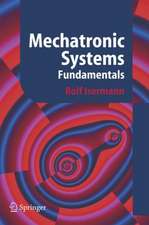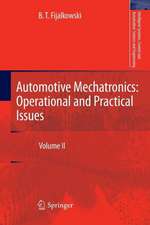Passivity-based Control of Euler-Lagrange Systems: Mechanical, Electrical and Electromechanical Applications: Communications and Control Engineering
Autor Romeo Ortega, Julio Antonio Loría Perez, Per Johan Nicklasson, Hebertt J. Sira-Ramirezen Limba Engleză Hardback – 16 sep 1998
| Toate formatele și edițiile | Preț | Express |
|---|---|---|
| Paperback (1) | 1393.58 lei 6-8 săpt. | |
| SPRINGER LONDON – 19 oct 2010 | 1393.58 lei 6-8 săpt. | |
| Hardback (1) | 1401.30 lei 6-8 săpt. | |
| SPRINGER LONDON – 16 sep 1998 | 1401.30 lei 6-8 săpt. |
Din seria Communications and Control Engineering
- 15%
 Preț: 659.70 lei
Preț: 659.70 lei - 20%
 Preț: 879.74 lei
Preț: 879.74 lei - 18%
 Preț: 953.65 lei
Preț: 953.65 lei - 18%
 Preț: 1117.03 lei
Preț: 1117.03 lei - 9%
 Preț: 1385.77 lei
Preț: 1385.77 lei - 18%
 Preț: 1128.08 lei
Preț: 1128.08 lei - 18%
 Preț: 953.65 lei
Preț: 953.65 lei - 15%
 Preț: 656.89 lei
Preț: 656.89 lei - 18%
 Preț: 896.52 lei
Preț: 896.52 lei - 18%
 Preț: 1113.26 lei
Preț: 1113.26 lei - 18%
 Preț: 1388.22 lei
Preț: 1388.22 lei - 15%
 Preț: 647.27 lei
Preț: 647.27 lei - 18%
 Preț: 954.45 lei
Preț: 954.45 lei - 18%
 Preț: 1231.47 lei
Preț: 1231.47 lei - 18%
 Preț: 948.92 lei
Preț: 948.92 lei - 18%
 Preț: 1232.57 lei
Preț: 1232.57 lei - 18%
 Preț: 1127.28 lei
Preț: 1127.28 lei - 15%
 Preț: 643.34 lei
Preț: 643.34 lei - 15%
 Preț: 651.51 lei
Preț: 651.51 lei - 20%
 Preț: 1454.07 lei
Preț: 1454.07 lei - 18%
 Preț: 948.79 lei
Preț: 948.79 lei - 18%
 Preț: 1233.06 lei
Preț: 1233.06 lei - 18%
 Preț: 947.85 lei
Preț: 947.85 lei - 18%
 Preț: 950.96 lei
Preț: 950.96 lei - 18%
 Preț: 956.99 lei
Preț: 956.99 lei - 15%
 Preț: 644.18 lei
Preț: 644.18 lei - 18%
 Preț: 946.87 lei
Preț: 946.87 lei - 18%
 Preț: 951.14 lei
Preț: 951.14 lei - 18%
 Preț: 961.55 lei
Preț: 961.55 lei - 15%
 Preț: 644.18 lei
Preț: 644.18 lei - 20%
 Preț: 990.80 lei
Preț: 990.80 lei - 18%
 Preț: 1006.72 lei
Preț: 1006.72 lei - 18%
 Preț: 942.44 lei
Preț: 942.44 lei - 18%
 Preț: 1233.06 lei
Preț: 1233.06 lei - 15%
 Preț: 641.85 lei
Preț: 641.85 lei - 18%
 Preț: 957.75 lei
Preț: 957.75 lei - 15%
 Preț: 649.87 lei
Preț: 649.87 lei - 18%
 Preț: 958.07 lei
Preț: 958.07 lei - 18%
 Preț: 1117.99 lei
Preț: 1117.99 lei - 18%
 Preț: 1395.94 lei
Preț: 1395.94 lei - 18%
 Preț: 781.62 lei
Preț: 781.62 lei - 18%
 Preț: 953.20 lei
Preț: 953.20 lei - 18%
 Preț: 1109.78 lei
Preț: 1109.78 lei
Preț: 1401.30 lei
Preț vechi: 1708.90 lei
-18% Nou
Puncte Express: 2102
Preț estimativ în valută:
268.15€ • 286.73$ • 223.57£
268.15€ • 286.73$ • 223.57£
Carte tipărită la comandă
Livrare economică 18 aprilie-02 mai
Preluare comenzi: 021 569.72.76
Specificații
ISBN-13: 9781852330163
ISBN-10: 1852330163
Pagini: 580
Ilustrații: XXXIV, 543 p.
Dimensiuni: 155 x 235 x 35 mm
Greutate: 1.03 kg
Ediția:1998
Editura: SPRINGER LONDON
Colecția Springer
Seria Communications and Control Engineering
Locul publicării:London, United Kingdom
ISBN-10: 1852330163
Pagini: 580
Ilustrații: XXXIV, 543 p.
Dimensiuni: 155 x 235 x 35 mm
Greutate: 1.03 kg
Ediția:1998
Editura: SPRINGER LONDON
Colecția Springer
Seria Communications and Control Engineering
Locul publicării:London, United Kingdom
Public țintă
ResearchCuprins
1 Introduction.- 2 Euler-Lagrange systems.- 3 Set-point regulation.- 4 Trajectory tracking control.- 5 Adaptive disturbance attenuation: Friction compensation.- 6 Modeling of switched DC-to-DC power converters.- 7 Passivity-based control of DC-to-DC power converters.- 8 Nested-loop passivity-based control: An illustrative example.- 9 Generalized AC motor.- 10 Voltage-fed induction motors.- 11 Current-fed induction motors.- 12 Feedback interconnected systems: Robots with AC drives.- 13 Other applications and current research.- A Dissipativity and passivity.- 1 Circuit example.- 3 Passivity and finite-gain stability.- 4 Feedback systems.- 5 Internal stability and passivity.- 6 The Kalman-Yakubovich-Popov lemma.- B Derivation of the Euler-Lagrange equations.- 1 Generalized coordinates and velocities.- 2 Hamilton’s principle.- 3 From Hamilton’s principle to the EL equations.- 4 EL equations for non-conservative systems.- 5 List of generalized variables.- 6 Hamiltonian formulation.- C Background material.- D Proofs.- 3 The BP transformation.- 3.1 Proof of Proposition 9.20.- 3.2 A Lemma on the BP Transformation.- 4 Proof of Eqs. (10.41) and (10.77).- 4.1 A theorem on positivity of a block matrix.- 4.2 Proof of Eq. (10.77).- 4.3 Proof of Eq. (10.41).- 5 Derivation of Eqs. (10.55) and (10.56).- 5.1 Derivation of Eq. (10.55).- 5.2 Derivation of Eq. (10.56).- 6 Boundedness of all signals for indirect FOC.- 6.1 Proof of Proposition 11.10.
Recenzii
From the reviews:
We highly recommend Passivity-based Control of Euler-Lagrange Systems: Mechanical, Electrical and Electromechanical Applications for bot the researcher interested in advanced passivity-based control techniques and the engineer seeking experimentally proven techniques. The pedagogical style of the authors lend to the readability and the flow of knowledge to the reader; hence, this text lends itself to classroom use as a graduate level text in passivity-based control.
Automatica 36 (2000) 1389 – 1391 (Reviewers: Warren E. Dixon and Darren M. Dawson)
…an attractive reference book for research and development engineers who are interested in modern methods of control theory. Also, can be used for advanced senior-level course in university.
IEEE Industrial Electronics Society Newsletter June (2001) 12 (Reviewer: Marian P. Kazmierkowsi)
We highly recommend Passivity-based Control of Euler-Lagrange Systems: Mechanical, Electrical and Electromechanical Applications for bot the researcher interested in advanced passivity-based control techniques and the engineer seeking experimentally proven techniques. The pedagogical style of the authors lend to the readability and the flow of knowledge to the reader; hence, this text lends itself to classroom use as a graduate level text in passivity-based control.
Automatica 36 (2000) 1389 – 1391 (Reviewers: Warren E. Dixon and Darren M. Dawson)
…an attractive reference book for research and development engineers who are interested in modern methods of control theory. Also, can be used for advanced senior-level course in university.
IEEE Industrial Electronics Society Newsletter June (2001) 12 (Reviewer: Marian P. Kazmierkowsi)
Notă biografică
Romeo Ortega obtained the Docteur D`Etat from the Polytechnical Institute of Grenoble, France in 1984 . He then joined the National University of Mexico, where he worked until 1989. He was a Visiting Professor at the University of Illinois, USA, in 1987-88 and at McGill University, Canada, in 1991-1992, and a Fellow of the Japan Society for Promotion of Science in 1990-1991. Currently he is in the Laboratoire des Signaux et Systèmes of Supélec in Gif-sur-Yvette, France, where he holds a position of Directeur de Recherche from the CNRS. His research interests are in the fields of nonlinear and adaptive control with special emphasis on applications. He is a co-author of the Springer-Verlag book Nonlinear Adaptive Control Design and Applications, and has published more than 100 scientific papers in international journals. Dr Ortega has been the chairman of the IEEE Working Group on Adaptive Control and Systems Identification, of the IFAC Technical Committee on Adaptive Control and Tuning and of the Automatica Paper Prize Award Committee. He has served as Associate Editor for various scientific journals. Dr Ortega is a member of the IFAC Technical Board and a Fellow of the IEEE.
Antonio Loría has been a research fellow at the University of Twente, NTNU Norway and UCSB, California. Currently, he has a tenure position as Associate Researcher with the National Centre for Scientific Research (CNRS), France. He is author of more than seventy scientific journal and conference papers as well as four book chapters in control theory; of these publications, more than 20 are on robot control. He is co-author of Control of Robot Manipulators in Joint Space by R. Kelly, V. Santibáñez and A. Loría, (1-85233-994-2).
Hebertt Sira-Ramirez has published his work in 4 books, 20 book chapters, many of them in Springer-Verlag volumes, 114 journal publications in credited, refereed, journals and over 192 specialized internationalconferences. He obtained his MSEE and his PhD, both from the Massachusetts Institute of Technology (Cambridge, USA) in 1972 and 1977, respectively. He worked as a professor, and researcher, for 28 years at the Universidad de Los Andes in Merida, Venezuela, and has worked for the last 7 years in a Scientific Research Institute in Mexico City (Cinvestav-IPN). He is a member of the IFAC Technical Committee on Non-Linear Control Systems.
Antonio Loría has been a research fellow at the University of Twente, NTNU Norway and UCSB, California. Currently, he has a tenure position as Associate Researcher with the National Centre for Scientific Research (CNRS), France. He is author of more than seventy scientific journal and conference papers as well as four book chapters in control theory; of these publications, more than 20 are on robot control. He is co-author of Control of Robot Manipulators in Joint Space by R. Kelly, V. Santibáñez and A. Loría, (1-85233-994-2).
Hebertt Sira-Ramirez has published his work in 4 books, 20 book chapters, many of them in Springer-Verlag volumes, 114 journal publications in credited, refereed, journals and over 192 specialized internationalconferences. He obtained his MSEE and his PhD, both from the Massachusetts Institute of Technology (Cambridge, USA) in 1972 and 1977, respectively. He worked as a professor, and researcher, for 28 years at the Universidad de Los Andes in Merida, Venezuela, and has worked for the last 7 years in a Scientific Research Institute in Mexico City (Cinvestav-IPN). He is a member of the IFAC Technical Committee on Non-Linear Control Systems.
Textul de pe ultima copertă
New technological developments have created engineering problems where nonlinear effects have to be taken into account for a successful controller design. Unfortunately, the existing theory for general nonlinear systems cannot successfully deal with them. This book, which summarises the experience of the authors on control engineering applications over the past ten years aims to overcome this drawback by:
• Giving back to modelling the central role that it deserves, and focusing on the structural aspects that can be exploited for the controller design.
• Formalising mathematically current engineering practice, which is usually developed from practical experience and considerations, as opposed to theoretical analysis.
• Proposing new control laws that sometimes are viewed as "upgrades" to the existing schemes.
• Experimental validation, that confronts the new schemes with other theoretical studies or with industrial controllers.
The fundamental concept of passivity and the perspective of control as a suitable interconnection of the system with its environment are key ingredients in all the developments of the book, which is primarily aimed at control-orientated graduate students and researchers, but which will also have value for both practising engineers and those concerned with the more theoretical side of the subject.
The Communications and Control Engineering series reflects the major technological advances which have a great impact in the fields of communication and control. It reports on the research in industrial and academic institutions around the world to exploit the new possibilities which are becoming available.
• Giving back to modelling the central role that it deserves, and focusing on the structural aspects that can be exploited for the controller design.
• Formalising mathematically current engineering practice, which is usually developed from practical experience and considerations, as opposed to theoretical analysis.
• Proposing new control laws that sometimes are viewed as "upgrades" to the existing schemes.
• Experimental validation, that confronts the new schemes with other theoretical studies or with industrial controllers.
The fundamental concept of passivity and the perspective of control as a suitable interconnection of the system with its environment are key ingredients in all the developments of the book, which is primarily aimed at control-orientated graduate students and researchers, but which will also have value for both practising engineers and those concerned with the more theoretical side of the subject.
The Communications and Control Engineering series reflects the major technological advances which have a great impact in the fields of communication and control. It reports on the research in industrial and academic institutions around the world to exploit the new possibilities which are becoming available.
Caracteristici
Passivity-based Control is highly topical within control engineering at the present time Bridges the gap between theory and practice in control of certain passive systems Its mathematical yet elementary approach will appeal to a wide-ranging audience














